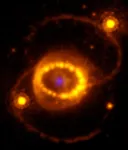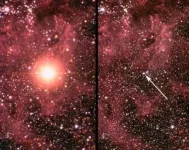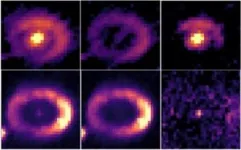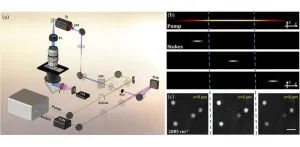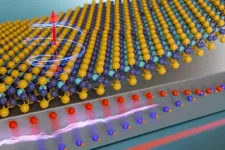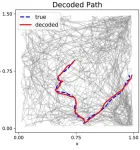(Press-News.org) Scientists can finally show that a neutron star formed from our most well-studied supernova, SN 1987A. The breakthrough was made possible thanks to the James Webb telescope.
Supernovae are the spectacular end result of the collapse of stars more massive than 8-10 times the mass of the sun. Besides being the main sources of chemical elements such as carbon, oxygen, silicon, and iron that make life possible, they are also responsible for creating the most exotic objects in the universe, neutron stars and black holes.
In 1987, supernova 1987A (SN 1987A) exploded in the Large Magellanic Cloud, which is located near the Milky Way. It was the first time in four centuries that a supernova became visible to the naked eye, giving astronomers an unprecedented close-up of a supernova explosion. Although SN 1987A is one of the most studied objects in the sky, the question of what was left after the explosion remains unanswered. Did it become a compact neutron star or a black hole? The detection of neutrinos, which are produced in the supernova, indicated that a super compact neutron star should have formed at the center of the SN 1987A. But even after three and a half decades of intensive observations with the best telescopes, no conclusive evidence of such a neutron star has been found, until now.
In a study published on February 22 in the journal Science, an international team of astronomers announced that they had detected signals from a neutron star from the centre of the nebula around SN 1987A. Using the James Webb Telescope (JWST), the authors were able to observe spectral lines that had either been created from the hot neutron star or from a so-called pulsar wind nebula around the neutron star.
“Thanks to the fantastic resolution and the new instruments at JWST, we have been able to examine the centre of the supernova and what was created after the explosion for the first time. We now know that there is a compact source of ionizing radiation there, which is likely a neutron star. This was predicted by the explosion models and we did simulations in 1992 that indicated how to observe this, but it was only with JWST that it became possible. However, the details offered several surprises,” says Claes Fransson, professor at the Department of Astronomy, Stockholm University and the Oskar Klein Centre and the lead author of the study.
“This is the latest in a series of surprises that this supernova has offered over the years. It was unexpected that the compact object would finally be detected through a very strong argon line, so it was a bit fun that it turned out this way,” says Josefin Larsson, professor at the Department of Physics, KTH Royal Institute of Technology and the Oskar Klein Centre and co-author of the study.
Read article in Science: Emission lines due to ionizing radiation from a compact object in the remnant of Supernova 1987A DOI: 10.1126/science.adj5796
Contact:
Claes Fransson, professor at the Department of Astronomy, Stockholm University and the Oskar Klein Centre
E-mail: claes@astro.su.se
Phone: ++46701610333
Josefin Larsson, professor at the Department of Physics, KTH Royal Institute of Technology and the Oskar Klein Centre
E-mail: josla@kth.se
-------
Supernova (SN)1987A – the most studied supernova
SN 1987A is the most studied and best observed supernova of all and therefore of particular importance to understanding these objects. Exploding on February 23, 1987 in the Large Magellanic Cloud in the southern sky at a distance of 160,000 light years, it was the closest supernova explosion since the supernova observed by Johannes Kepler in 1604. For several months, it was possible to see SN 1987A with the naked eye.
SN 1987A is the only supernova that has been observed via its neutrinos (almost massless particles with an extremely weak interaction with other matter). This was important because 99.9 percent of the enormous energy released in this event was predicted to be lost in these particles. The remaining 0.1 percent was sent away in the form of light and kinetic energy. Of the huge number (about 1058) of neutrinos emitted, about 20 were detected by three different detectors around the Earth. SN 1987A was also the first supernova in which the exploding star could be identified from images taken before the explosion. This allowed the mass of the star to be determined, which agreed well with theoretical models.
Black hole or neutron star was created
Apart from the neutrinos, the most interesting consequence of the explosion is the prediction that it will collapse into a black hole or neutron star. This compact remnant was created by the collapsed star's core, and has a mass about 1.5 times that of the Sun. The remaining mass was pushed away at up to 10 percent of the speed of light, forming the expanding remnant we can observe today.
The astronomers studying SN 1987A suspected that a neutron star had formed after the explosion. The main indication came from the neutrino pulse's duration of 10 seconds. But despite further indications from radio and X-ray observations, no conclusive evidence for a neutron star has been found until now. An important reason is the large amount of dust that formed in the years after the explosion. This dust can block most of the visible light from the center, obscuring the compact object at visible wavelengths. Identifying the final product of the explosion was the main remaining unsolved problem for SN 1987A.
James Webb Space Telescope made breakthroughs possible
The James Webb Space Telescope (JWST) can observe light at infrared wavelengths, which can more easily travel through the dust that blocks visible light. An international team of astronomers studied SN 1987A using two of the telescope's instruments, MIRI* and NIRSpec. They then saw a point source in the centre of the widespread supernova remnant, emitting light from argon and sulfur ions (see Figs. 1+3). Thanks to JWST's resolution, and the ability of its instruments to accurately determine the velocity of the emitting source, we know that this point source is very close to the centre of the supernova explosion.
While most of the exploding star's mass is expanding at up to 10,000 km/second and has therefore been spread over a large volume, the observed source is still close to the explosion site. This is what astronomers expect for the compact remnant after the explosion. The observed spectral lines from argon and sulfur come from ionized atoms, requiring high-energy photons from the compact object. How this can happen as a result of the ultraviolet and X-ray radiation from a neutron star was already predicted in 1992 by Roger Chevalier (University of Virginia) and Claes Fransson.
Two possible explanations
The scientists do not see the neutron star directly. Instead, they infer its existence by observing how its radiation affects its surroundings. In their study, the authors discuss two main explanations for the observed spectral lines. They may have been created due to the radiation from either the hot, newborn neutron star, which has a surface temperature of more than a million degrees, or from energetic particles accelerated in the strong magnetic field of the rapidly rotating neutron star (which is also called a pulsar). This is the same mechanism that takes place around the pulsar at the centre of the famous Crab Nebula, which is the remnant of a supernova observed by Chinese astronomers in 1054.
Both of these explanatory models result in similar predictions for what kind of spectral lines are created. To distinguish between these two models, further observations with JWST and ground-based telescopes in visible light, as well as the Hubble telescope, are therefore required.
Regardless, the new JWST observations provide compelling evidence for the existence of a compact object, likely a neutron star, at the centre of SN 1987A. The radius of such a neutron star is approximately 10 km, which means that the density is as great as in an atomic nucleus. One cubic millimeter of such stellar matter weighs about as much as a supertanker!
In summary, the new JWST observations, along with previous observations of the exploding star and the neutrinos created in the explosion, provide a complete picture of this unique object.
The team behind these results consists of 34 authors from 12 countries in Europe and the USA. First author is Claes Fransson, professor at the Department of Astronomy at Stockholm University and the Oskar Klein Centre.
* MIRI is an instrument that researchers at Stockholm University helped develop.
END
James Webb telescope detects traces of neutron star in iconic supernova
2024-02-22
ELSE PRESS RELEASES FROM THIS DATE:
Enhanced 3D chemical imaging with phase-modulation
2024-02-22
Understanding complex biological and biomedical systems is greatly aided by 3D imaging, which provides much more detailed information than traditional two-dimensional methods. However, live cell and tissue imaging remain challenging due to factors like limited imaging speed and significant scattering in turbid environments.
In this context, multimodal microscopy techniques are notable. Specifically, nonlinear techniques like CRS (coherent Raman scattering) use optical vibrational spectroscopy, providing precise chemical imaging in tissues and cells in a label-free way. Furthermore, stimulated Raman scattering (SRS) ...
Researchers harness 2D magnetic materials for energy-efficient computing
2024-02-22
CAMBRIDGE, MA — Experimental computer memories and processors built from magnetic materials use far less energy than traditional silicon-based devices. Two-dimensional magnetic materials, composed of layers that are only a few atoms thick, have incredible properties that could allow magnetic-based devices to achieve unprecedented speed, efficiency, and scalability.
While many hurdles must be overcome until these so-called van der Waals magnetic materials can be integrated into functioning computers, MIT researchers took an important step in this direction by demonstrating precise control of a van der ...
Empowering autistic teens: New clinician advice for navigating chronic pain
2024-02-22
When you’re an autistic teenager living with chronic pain, getting treatment for your pain can be a challenging experience. That’s according to a group of young people who’ve spoken to Dr. Abbie Jordan of the Department of Psychology and Centre for Pain Research at The University of Bath about their experiences. Teenagers mention sensory issues, a lack of autism awareness among staff, or feeling “doubly different” compared to their peers, making receiving “one-size-fits-all” psychologically focused treatment for their chronic pain ...
Climate change linked to rise in mental distress among teens, according to Drexel study
2024-02-22
Worsening human-induced climate change may have effects beyond the widely reported rising sea levels, higher temperatures, and impacts on food supply and migration – and may also extend to influencing mental distress among high schoolers in the United States.
According to a representative survey of 38,616 high school students from 22 public school districts in 14 U.S. states, the quarter of those adolescents who had experienced the highest number of days in a climate disaster within the past two years and the past five years – such as hurricanes, floods, tornadoes, droughts, and wildfire – had 20% higher odds of developing mental ...
Combination of group competition and repeated interactions promotes cooperation
2024-02-22
One of the great unresolved mysteries of human evolution is how pro-social, cooperative behavior could have evolved. What led to the establishment of a behavior that prioritizes the benefit of the community over that of the individual in a world where materially successful individuals reproduce, and others slowly perish?
The prevailing theory suggests that this occurred due to repeated interactions. Over generations, humans learned that cooperative behavior pays off in the long run. People collaborate because they anticipate interacting with the same individuals ...
A new beginning: The search for more temperate Tatooines
2024-02-22
New Haven, Conn. — Luke Skywalker’s childhood might have been slightly less harsh if he’d grown up on a more temperate Tatooine — like the ones identified in a new, Yale-led study.
According to the study’s authors, there are more climate-friendly planets in binary star systems — in other words, those with two suns — than previously known. And, they say, it may be a sign that, at least in some ways, the universe leans in the direction of orderly alignment rather than chaotic misalignment.
For the study, ...
Moffitt study highlights urgent need to address impact of extreme weather events on cancer survivorship
2024-02-22
TAMPA, Fla. — Hurricanes and other extreme weather events pose immediate threats to life and property and have long-lasting impacts on health outcomes, particularly for cancer survivors. In a mini-review published today in Cancer Epidemiology, Biomarkers & Prevention, a journal from the American Association for Cancer Research, Moffitt Cancer Center researchers shed light on the significant gaps in understanding and addressing the effects of hurricanes and extreme weather events on biological, psychosocial and clinical outcomes among cancer survivors.
Researchers ...
Scientists can tell where a mouse is looking and located based on its neural activity
2024-02-22
Researchers have paired a deep learning model with experimental data to “decode” mouse neural activity. Using the method, they can accurately determine where a mouse is located within an open environment and which direction it is facing just by looking at its neural firing patterns. Being able to decode neural activity could provide insight into the function and behavior of individual neurons or even entire brain regions. These findings, publishing February 22 in Biophysical Journal, could also inform the design of intelligent machines that currently ...
Artificial intelligence matches or outperforms human specialists in retina and glaucoma management, Mount Sinai study finds
2024-02-22
A large language model (LLM) artificial intelligence (AI) system can match, or in some cases outperform, human ophthalmologists in the diagnosis and treatment of patients with glaucoma and retina disease, according to research from New York Eye and Ear Infirmary of Mount Sinai (NYEE).
The provocative study, published February 22, in JAMA Ophthalmology, suggests that advanced AI tools, which are trained on vast amounts of data, text, and images, could play an important role in providing decision-making support to ophthalmologists in the diagnosis and management of cases involving glaucoma and retina ...
A third of trans masculine individuals on testosterone ovulate
2024-02-22
"Trans masculine people are people born female but do not identify as such, for example they feel male, gender fluid or non-binary. Our examination of their ovarian tissue shows that 33% of them show signs of recent ovulation, despite being on testosterone and no longer menstruating," says Joyce Asseler, PhD candidate at Amsterdam UMC.
Trans masculine people often use hormone treatment with testosterone to masculinize physically. This hormone usually stops them from menstruating. In that ...
